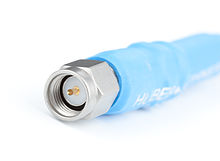Kjell & Company: SMA-produkter
Från Wikipedia:
SMA (SubMiniature version A) connectors are semi-precision coaxial RF connectors developed in the 1960s as a minimal connector interface for coaxial cable with a screw-type coupling mechanism. The connector has a 50 Ω impedance. SMA is designed for use from DC to 18 GHz, but is most commonly used for hand-held radio and mobile telephone antenna, and more recently with WiFi antenna systems and USB Software Defined Radio dongles.
SMA connectors can be visually confused with the standard household 75-ohm type F coax connector (diameters: Male 7⁄16 inch (11 mm) circular or hex; female 3⁄8 in (9.5 mm) external threads), as there is only about a 2 mm difference overall in the specifications. Type F cannot be mated with SMA; this connection is possible using an adapter.
The SMA name is also used for a superficially similar optical fiber connector.
The SMA connector employs a 1/4-inch diameter, 36-thread-per-inch threaded barrel. The male is equipped with a hex nut measuring 5/16 inch (0.3125 inch / 7.9 mm) across opposite flats, thus taking the same wrench as a #6 SAE hex nut.
A standard-polarity SMA male connector has a center pin surrounded by barrel with inside threads, and the standard SMA female connector has a center sleeve surrounded by a barrel with outside threads. As with most other connectors, the gender assignment thus corresponds to the innermost electrical component. There are also reverse-polarity ("RP") SMA connectors in which the pin and sleeve are swapped; so that the "male" RP-SMA has a center sleeve surrounded by an inside-threaded barrel, and the "female" RP-SMA has a center pin and an outside-threaded barrel. See below for a fuller description.
The SMA connector uses a polytetrafluoroethylene (PTFE) dielectric which will contact along the mating plane. Variability in the construction and the mating of the connectors limit the repeatability of the connector impedance. For that reason and that they are just rated for a limited number of connection cycles, an SMA connector is not usually a good choice for metrological applications.
SMA connectors are rated for up to 500 mating cycles, but to achieve this it is necessary to properly torque the connector when making the connection. A 5/16-inch torque wrench is required for this, set to 3–5 in·lbf (0.3 to 0.6 Nm) for brass, and 7–10 in·lbf (0.8 to 1.1 Nm) for stainless steel connectors. Flats are sometimes also provided on the cable side of the connector assembly so that a second wrench can be used to prevent it from rotating and damaging the joint to the cable. It is also advisable to inspect and clean out loose debris from the internal surfaces with compressed air or a gas duster can before mating.
The SMA connector is typically rated for mode-free operation from DC to 18 GHz, though some proprietary versions are rated to 26.5 GHz. For performance above this, SMA-like connectors are used. These are the 3.5 mm connector, rated to 34 GHz, and the 2.92 mm (also known as 2.9 mm, K type, or SMK), good up to 46 GHz. These connectors keep the same outside thread as the SMA, so they can potentially be cross-mated, but the precision connector can be easily damaged when mating with low-grade SMA connectors. The precision versions use an air dielectric with appropriately scaled center conductors.
Beyond 46 GHz, the 2.4 mm, 1.85 mm (also known as V type) and 1.0 mm (also known as W type) connectors exist. These are similar to the SMA connector, but with the geometries incompatibly scaled. These have mode-free operation to 50, 65, and 110 GHz respectively.
Reverse-polarity SMA (RP-SMA or RSMA) is a variation of the SMA connector specification which reverses the gender of the interface, as shown in Figures 1 and 2. The term "reverse polarity" here refers only to the gender of the connector's contact pin, not in any way to the signal polarity.
The female RP-SMA connector has the same external housing as a standard or conventional female SMA connector, which consists of an outer shell with the threads on the outside; however, the center receptacle is replaced by a male pin.
Similarly, the RP-SMA male has threads on the inside like a conventional male, but has a center receptacle instead of the male pin in the middle. Normal SMA connectors are incompatible with RP-SMA connectors.
| Center pin | Center receptacle | |
|---|---|---|
| Internal thread | SMA male/plug | RP-SMA male/plug |
| External thread | RP-SMA female/jack | SMA female/jack |
Because they were not readily available, RP-SMA connectors have been widely used by Wi-Fi equipment manufacturers to comply with specific national regulations, such as those from the FCC, which are designed to prevent consumers from connecting antennas which exhibit gain and therefore breach compliance.
The US FCC considered that the RP-SMA was acceptable in preventing consumers changing the antenna; but by 2000 it regarded them as readily available, though delaying its ruling indefinitely. As of 2013, leading manufacturers are still using RP-SMA connectors on their Wi-Fi equipment.


